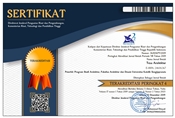ANALISIS PENERAPAN NEARLY ZERO EMISSION BUILDING DALAM UPAYA MENGURANGI EMISI KARBON PADA SEKTOR BANGUNAN (Analysis of the Implementation of Nearly Zero Emission Buildings Efforts to Reduce Carbon Emissions in the Building Sector)
Abstract
Indonesia's urbanization issue ranks fourth in Southeast Asia. Urbanization correlates with a 1% increase in emissions for every 1% increase in the population. In the building sector, this trend will increase the demand for building construction, impacting building resources such as power plants (energy sector). The energy sector contributes the highest carbon emissions at 94.64%. This rise in carbon emissions can hinder the goal of reducing emissions by 29% by 2030. The Nearly Zero Emission Building (NZEB) approach is proposed as a solution for energy efficiency. The NZEB approach involves steps during the pre-construction phase using passive strategies and post-construction with active strategies through building operations to reduce building energy needs. This research uses a qualitative method based on three standards from three countries with different climates to review the implementation results. The analysis results show three strategies: passive strategies (orientation, natural lighting, and ventilation), active strategies (Building Management Systems (BMS), renewable energy use, and building materials), and alignment with Green Building to maximize this approach. In Indonesia, alignment with the Green Building Council Indonesia (GBCI) is necessary. GBCI has designed Greenship "Net Zero," focusing on assessments such as air quality, natural openings, and carbon emission reduction calculations. This will help quantitatively reduce carbon emissions in the building sector.
Keywords
Full Text:
PDF (Bahasa Indonesia)References
Abdellah, R. H., Nasid Masrom, M. A., Chen, G. K., Mohamed, S., & Omar, R. (2017). The potential of net zero energy buildings (NZEBs) concept
at design stage for healthcare buildings towards sustainable development. IOP Conference Series: Materials Science and Engineering, 271,
https://doi.org/10.1088/1757-899X/271/1/012021
Angelucci, F. (2018). Technological Dimensions of Nearly ZEB Design: Evolving toward a Nearly Zero Energy Oriented Landscape. Journal of
Technology Innovations in Renewable Energy, 6(3), 80–85. https://doi.org/10.6000/1929-6002.2017.06.03.1
ArchDaily. (2012, September 25). ArchDaily. Retrieved from The Crystal / Wilkinson Eyre Architects: https://www.archdaily.com/275111/the-
crystal-wilkinson-eyre-architects
ArchDaily. (2012, October 18). ArchDaily. Retrieved from ZCB Zero Carbon Building / Ronald Lu and Partners:
https://www.archdaily.com/282880/zcb-zero-carbon-building-ronald-lu-and-partners
Architizer. (2024). Architizer. Retrieved from Zero Energy Building at BCA Academy: https://architizer.com/projects/zero-energy-building-at-bca-
academy/
Attia, S., Kurnitski, J., Kosiński, P., Borodiņecs, A., Deme Belafi, Z., István, K., Krstić, H., Moldovan, M., Visa, I., Mihailov, N., Evstatiev, B.,
Banionis, K., Čekon, M., Vilčeková, S., Struhala, K., Brzoň, R., & Laurent, O. (2022). Overview and future challenges of nearly zero-energy
building (nZEB) design in Eastern Europe. Energy and Buildings, 267, 112165. https://doi.org/10.1016/j.enbuild.2022.112165
Azhar, F. B. T., & Wismadi, A. (2020). KAJIAN MENGENAI IMPLEMENTASI PENDEKATAN NZEB (NEARLY ZERO-ENERGY BUILDING) SEBAGAI
SOLUSI KELANGKAAN ENERGI KONVENSIONAL. Seminar Karya & Pameran Arsitektur Indonesia 2020, 2020-02–2, 450–461.
http://hdl.handle.net/123456789/43353
Badan Standardisasi Nasional. (2010). Konservasi energi selubung bangunan pada bangunan gedung. Jakarta: Badan Standardisasi Nasional.
Berian E., S. (2014). Landscape Design Strategies Development for the Zero Carbon Building and Park Project. Zero Carbon Building Journal, 1,
–59.
Chow, L. (2018). Zero Carbon Buiding - Microclimate (Building Design Considerations and Future Development). Hong Kong: CIC-ZCP.
CIC-ZCP (Construction Industry Council & Zero Carbon Park. (2022). CIC-ZCP (Construction Industry Council & Zero Carbon Park. Retrieved from
Renewable Energy: https://zcp.cic.hk/eng/renewable-energy
CIC-ZCP (Construction Industry Council & Zero Carbon Park. (2022). CIC-ZCP (Construction Industry Council & Zero Carbon Park. Retrieved from
Passive Design: https://zcp.cic.hk/eng/passive-design
CIC-ZCP (Construction Industry Council & Zero Carbon Park). (2022). CIC-ZCP (Construction Industry Council & Zero Carbon Park). Retrieved
from Low Carbon Construction and Materials: https://zcp.cic.hk/eng/low-carbon-construction-and-materials
Building and Construction Authority (BCA). (2023). Super Low Energy Building Technology Roadmap.
Green Building Council Indonesia. (2020). Greenship Net Zero (Green Building Council Indonesia, Ed.). Green Building Council Indonesia.
Gunawan, B., Budiharjo, S. Juwana, J., Priatman, J., Sujatmitko, W., & Sulisyanto, T. (2012). Buku Pedoman Energi Efisiensi untuk Desain
Bangunan Gedung di Indonesia (Kementerian ESDM, Ed.; 1st ed., Vol. 2). Kementerian ESDM.
Hugh. (2022, Januari). Cross Ventilation: Best Strategies and Benefits. Retrieved from architropics: https://architropics.com/cross-ventilation/
Kementerian ESDM. (2019). Inventarisasi Emisi GRK Sektor Energi (Sunarti, Ed.; 1st ed., Vol. 1). Kementerian ESDM.
Ke, Z., Liu, X., Zhang, H., Jia, X., Zeng, W., Yan, J., Hu, H., & Hien, W. N. (2023). Energy Consumption and Carbon Emissions of Nearly Zero-Energy
Buildings in Hot Summer and Cold Winter Zones of China. Sustainability, 15(14), 11453. https://doi.org/10.3390/su151411453
Koesalamwardi, A. B., Eldrian, A., Irene, & Tjahyadi, W. (2020). KELAYAKAN FINANSIAL NEAR ZERO ENERGY BUILDING DENGAN PERATURAN
KEMENTERIAN ENERGI DAN SUMBER DAYA MINERAL NO. 49 TAHUN 2018 MENGENAI INSENTIF ENERGI TERBARUKAN. Jurnal Infrastruktur,
(1), 69–75. https://doi.org/10.35814/infrastruktur.v6i1.1421
Latief, Y., Berawi, M. A., Koesalamwardi, A. B., Sagita, L., & Petroceany, J. S. (2017a). Defining Design Parameters for Housing Development in
Tropical Climates Using the Near Zero Energy House (nZEH) Concept. International Journal of Technology, 8(6), 1131.
https://doi.org/10.14716/ijtech.v8i6.719
Latief, Y., Berawi, M. A., Koesalamwardi, A. B., Sagita, L., & Petroceany, J. S. (2017b). Defining Design Parameters for Housing Development in
Tropical Climates Using the Near Zero Energy House (nZEH) Concept. International Journal of Technology, 8(6), 1131.
https://doi.org/10.14716/ijtech.v8i6.719
Leung, M. K. (2014). Sub Tropical Low/ Zero Carbon Architecture for Eco Efficiency. Zero Carbon Building Journal, 1, 16–23.
LKH Project. (2022). Natural Lighting in Architecture and its benefits. Retrieved from LKH Project: https://www.lkhpd.com.sg/natural-lighting-in-
architecture/
Maria, I. (2021). Pengaruh Pertumbuhan Penduduk dan Perubahan Iklim terhadap Ketersediaan Air. Online Journal Unja, 2(2), 135–140.
Mila A., Y. (2016). Sustainable Architecture (Ade M. Drajat, Ed.). Penerbit Erlangga.
Pusparisa, Y. (2019, 10 08). Tingkat Urbanisasi Indonesia dalam Kategori Menengah. Retrieved from Databoks:
https://databoks.katadata.co.id/datapublish/2019/10/08/tingkat-urbanisasi-indonesia-dalam-kategori-menengah
Ravi Chandu Kolusu, L. (2017, Maret 23). slideshare.com. Retrieved from THE CRYSTAL, LONDON: A SUSTAINABLE INTELLIGENT BUILDING:
https://www.slideshare.net/slideshow/the-crystal-london-a-sustainable-intelligent-building-casestudy-by-lakshmi-ravi-chandu-kolusu/73525877
Wittkopf, S. (2015, Maret 25). High Performing Buildings. Retrieved from Zero Energy Building @ BCA Academy: Singapore:
https://www.hpbmagazine.org/zero-energy-building-bca-academy-singapore/
Wittkopf, S. (2015). Tropical Net Zero.
Yau, R. (2014). The ZCB - Hong Kong’s First Zero Carbon Building and It’s key carbon neutrality strategies. Zero Carbon Building Journal, 1, 25–
DOI: https://doi.org/10.24167/tesa.v22i1.12159
ISSN 1410-6094 (Print) | ISSN 2460-6367 (Media Online) | View My Stats

This work is licensed under a Creative Commons Attribution 4.0 International License.








